Japan Earthquake & Tsunami: A Case Study of Risk Management Failure
VerifiedAdded on 2021/05/30
|8
|1012
|36
Report
AI Summary
This report provides an in-depth analysis of the risk management failures that occurred during the devastating 2011 Japan earthquake and tsunami. It highlights the catastrophic consequences, including the loss of life, property damage, and economic impact, which amounted to over $300 billio...
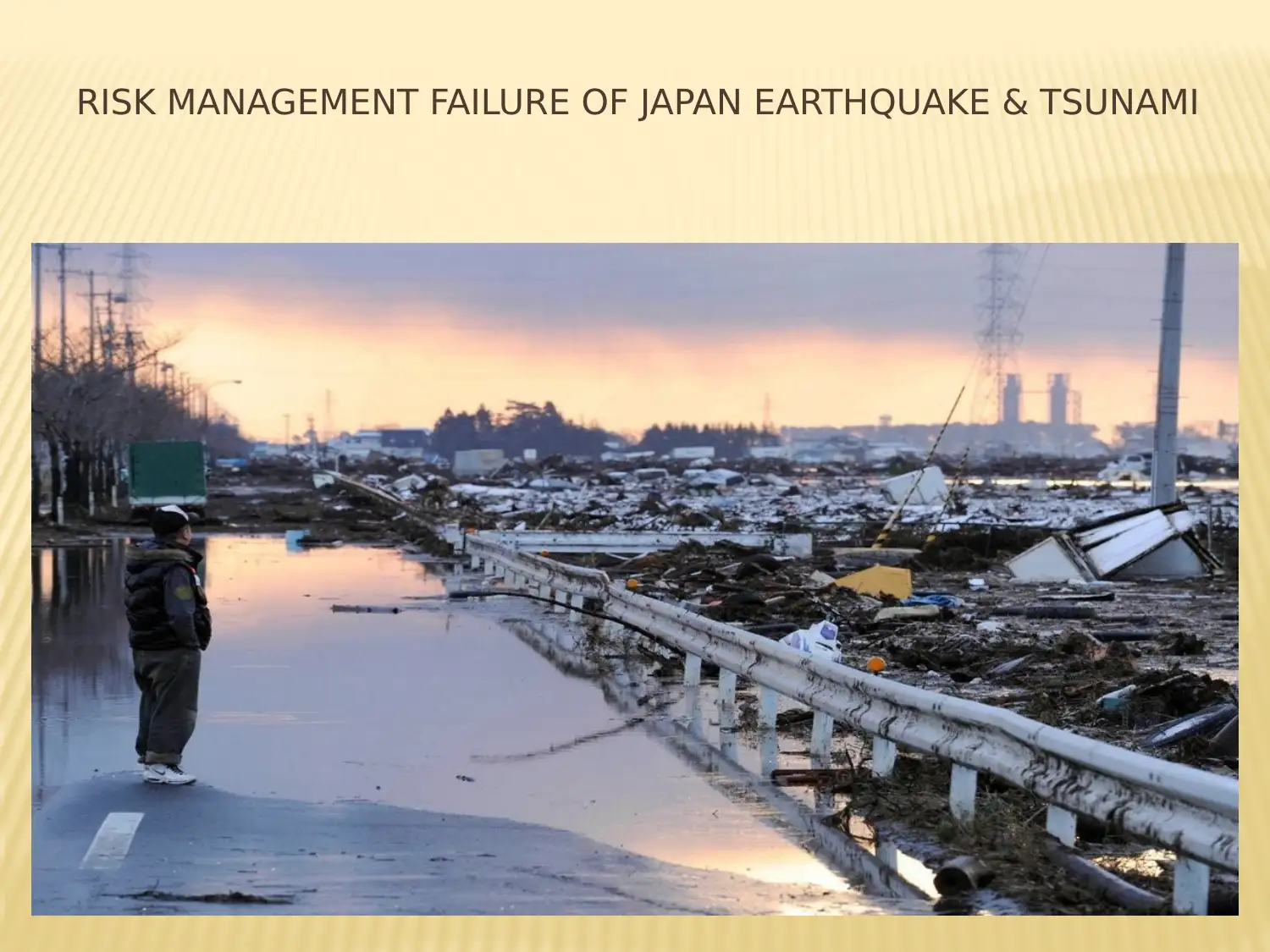
RISK MANAGEMENT FAILURE OF JAPAN EARTHQUAKE & TSUNAMI
Paraphrase This Document
Need a fresh take? Get an instant paraphrase of this document with our AI Paraphraser
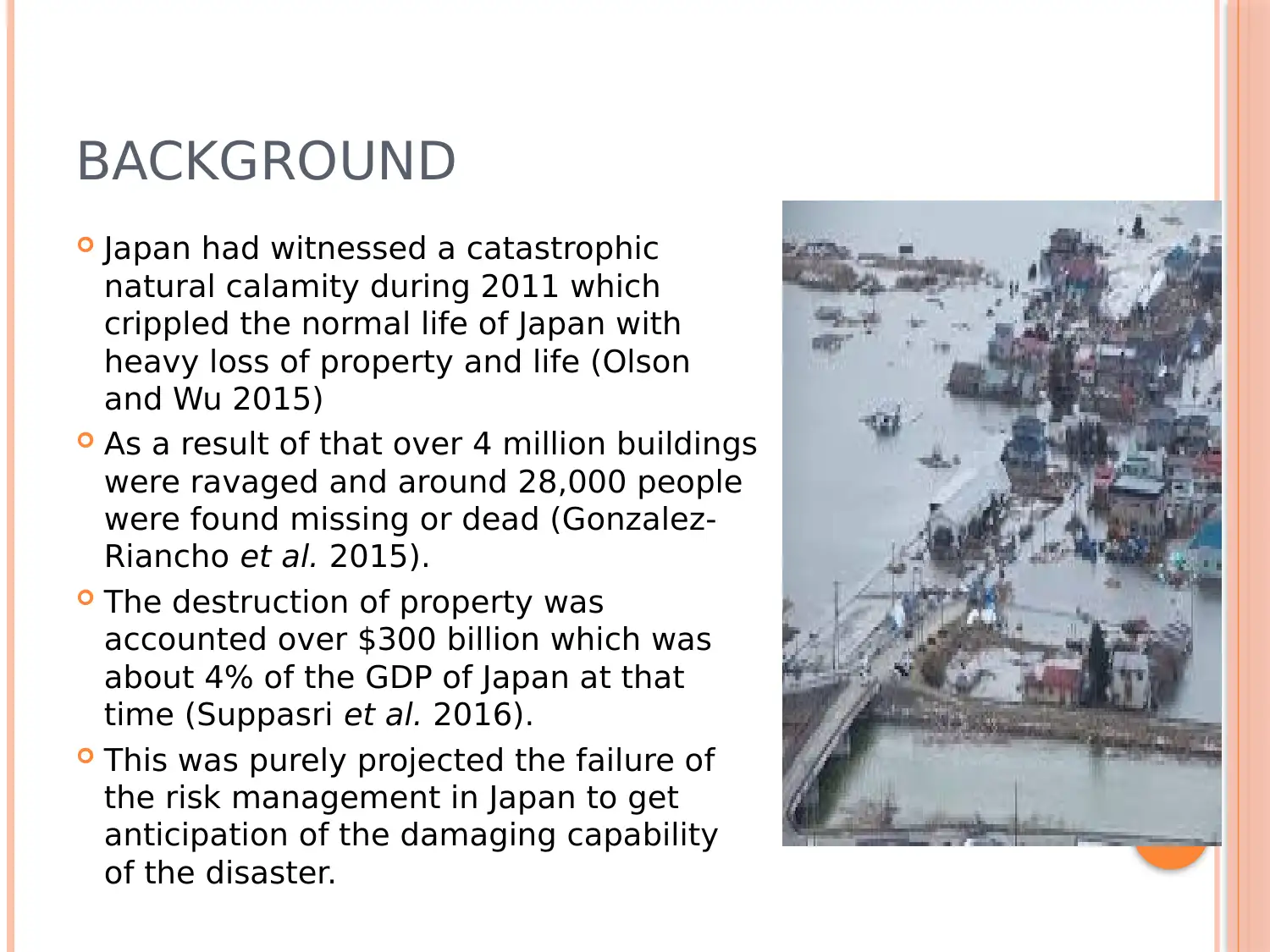
BACKGROUND
Japan had witnessed a catastrophic
natural calamity during 2011 which
crippled the normal life of Japan with
heavy loss of property and life (Olson
and Wu 2015)
As a result of that over 4 million buildings
were ravaged and around 28,000 people
were found missing or dead (Gonzalez-
Riancho et al. 2015).
The destruction of property was
accounted over $300 billion which was
about 4% of the GDP of Japan at that
time (Suppasri et al. 2016).
This was purely projected the failure of
the risk management in Japan to get
anticipation of the damaging capability
of the disaster.
Japan had witnessed a catastrophic
natural calamity during 2011 which
crippled the normal life of Japan with
heavy loss of property and life (Olson
and Wu 2015)
As a result of that over 4 million buildings
were ravaged and around 28,000 people
were found missing or dead (Gonzalez-
Riancho et al. 2015).
The destruction of property was
accounted over $300 billion which was
about 4% of the GDP of Japan at that
time (Suppasri et al. 2016).
This was purely projected the failure of
the risk management in Japan to get
anticipation of the damaging capability
of the disaster.
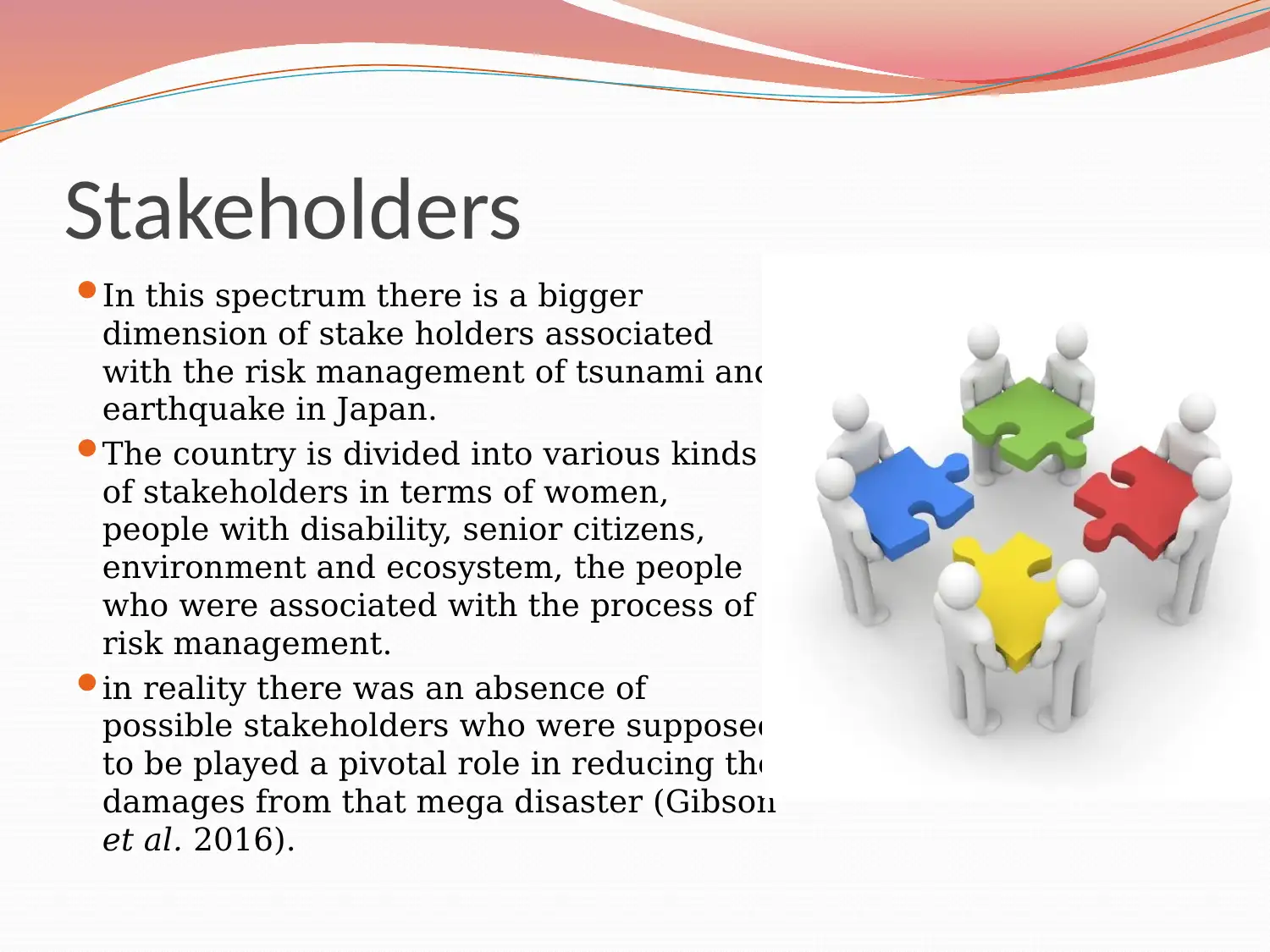
Stakeholders
In this spectrum there is a bigger
dimension of stake holders associated
with the risk management of tsunami and
earthquake in Japan.
The country is divided into various kinds
of stakeholders in terms of women,
people with disability, senior citizens,
environment and ecosystem, the people
who were associated with the process of
risk management.
in reality there was an absence of
possible stakeholders who were supposed
to be played a pivotal role in reducing the
damages from that mega disaster (Gibson
et al. 2016).
In this spectrum there is a bigger
dimension of stake holders associated
with the risk management of tsunami and
earthquake in Japan.
The country is divided into various kinds
of stakeholders in terms of women,
people with disability, senior citizens,
environment and ecosystem, the people
who were associated with the process of
risk management.
in reality there was an absence of
possible stakeholders who were supposed
to be played a pivotal role in reducing the
damages from that mega disaster (Gibson
et al. 2016).
⊘ This is a preview!⊘
Do you want full access?
Subscribe today to unlock all pages.

Trusted by 1+ million students worldwide
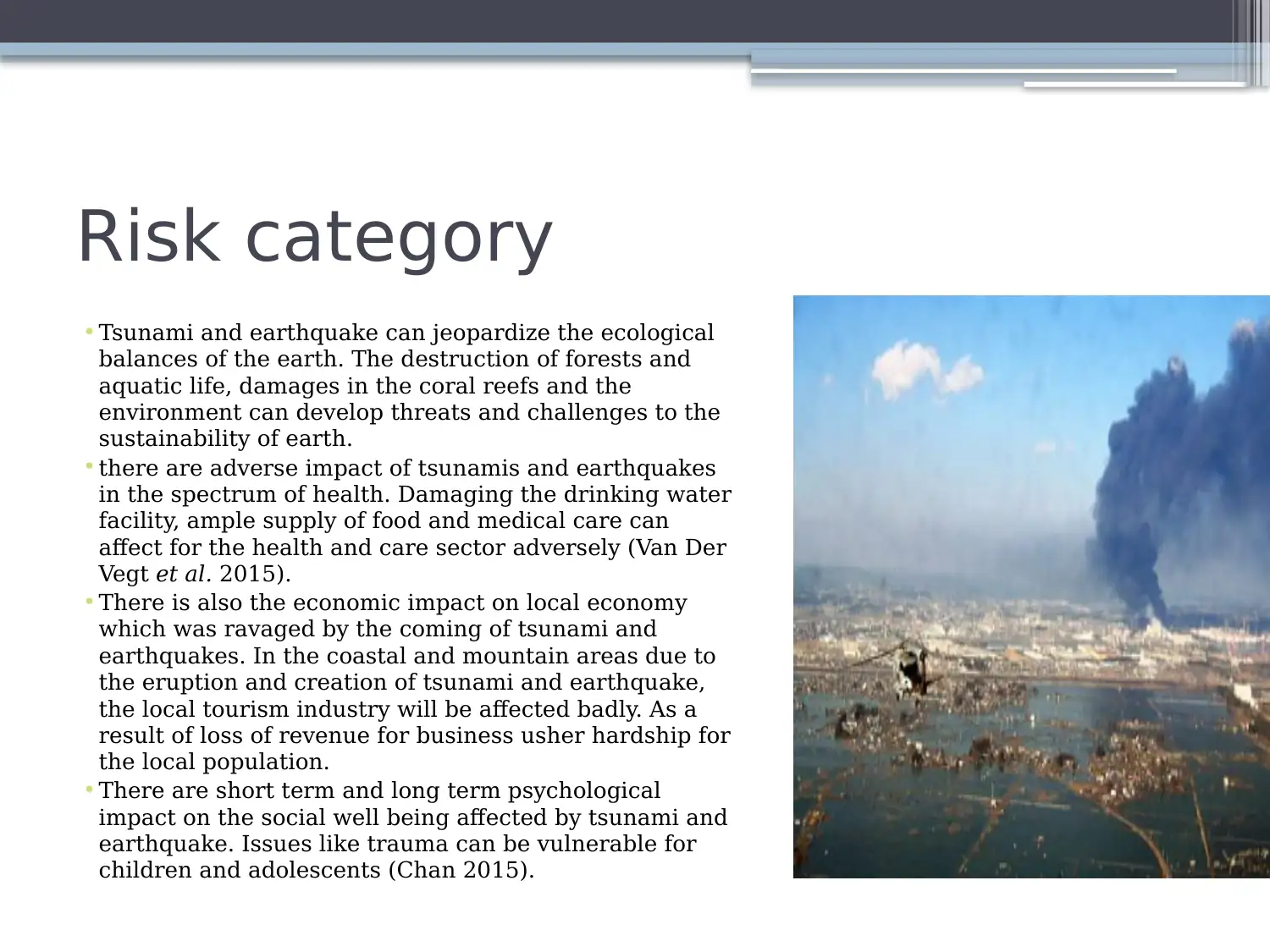
Risk category
• Tsunami and earthquake can jeopardize the ecological
balances of the earth. The destruction of forests and
aquatic life, damages in the coral reefs and the
environment can develop threats and challenges to the
sustainability of earth.
• there are adverse impact of tsunamis and earthquakes
in the spectrum of health. Damaging the drinking water
facility, ample supply of food and medical care can
affect for the health and care sector adversely (Van Der
Vegt et al. 2015).
• There is also the economic impact on local economy
which was ravaged by the coming of tsunami and
earthquakes. In the coastal and mountain areas due to
the eruption and creation of tsunami and earthquake,
the local tourism industry will be affected badly. As a
result of loss of revenue for business usher hardship for
the local population.
• There are short term and long term psychological
impact on the social well being affected by tsunami and
earthquake. Issues like trauma can be vulnerable for
children and adolescents (Chan 2015).
• Tsunami and earthquake can jeopardize the ecological
balances of the earth. The destruction of forests and
aquatic life, damages in the coral reefs and the
environment can develop threats and challenges to the
sustainability of earth.
• there are adverse impact of tsunamis and earthquakes
in the spectrum of health. Damaging the drinking water
facility, ample supply of food and medical care can
affect for the health and care sector adversely (Van Der
Vegt et al. 2015).
• There is also the economic impact on local economy
which was ravaged by the coming of tsunami and
earthquakes. In the coastal and mountain areas due to
the eruption and creation of tsunami and earthquake,
the local tourism industry will be affected badly. As a
result of loss of revenue for business usher hardship for
the local population.
• There are short term and long term psychological
impact on the social well being affected by tsunami and
earthquake. Issues like trauma can be vulnerable for
children and adolescents (Chan 2015).
Paraphrase This Document
Need a fresh take? Get an instant paraphrase of this document with our AI Paraphraser

The magnitude of the devastation was so
fatal that it took the country aback up to
10 years. It was estimated that 1.68
million people were died in Japan due to
the lack of risk management efficiency
and warning.
an amount of 62,000 people sought
shelter because of the malfunctioning of
the risk management (Gonzalez-Riancho
et al. 2015).
In Japan only the loss of property was
estimated at an amount of approximately
$300 billion which was about 4% of the
national gross domestic product (GDP) of
the country (Suppasri et al. 2016).
Fatal facts
fatal that it took the country aback up to
10 years. It was estimated that 1.68
million people were died in Japan due to
the lack of risk management efficiency
and warning.
an amount of 62,000 people sought
shelter because of the malfunctioning of
the risk management (Gonzalez-Riancho
et al. 2015).
In Japan only the loss of property was
estimated at an amount of approximately
$300 billion which was about 4% of the
national gross domestic product (GDP) of
the country (Suppasri et al. 2016).
Fatal facts
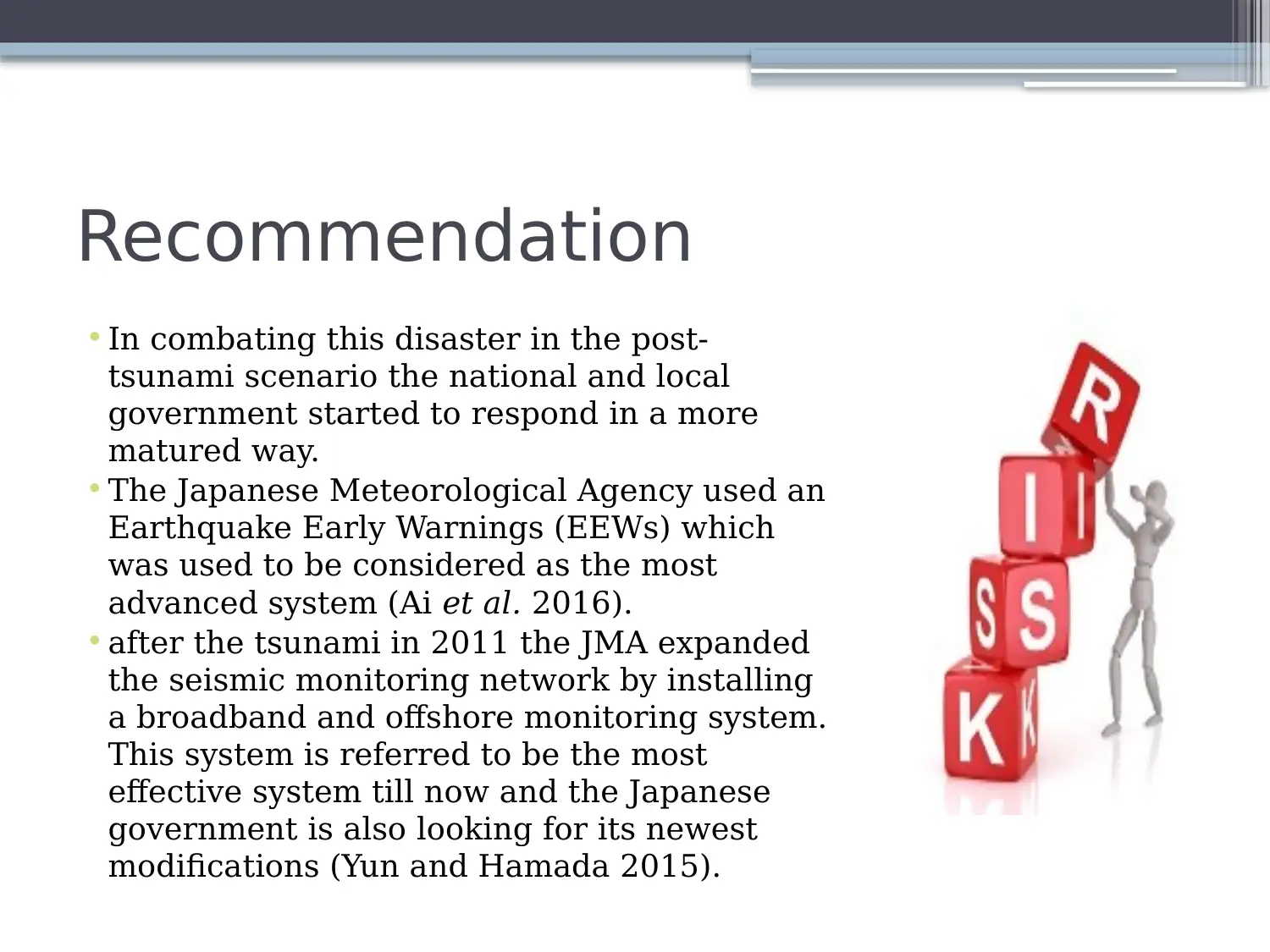
Recommendation
• In combating this disaster in the post-
tsunami scenario the national and local
government started to respond in a more
matured way.
• The Japanese Meteorological Agency used an
Earthquake Early Warnings (EEWs) which
was used to be considered as the most
advanced system (Ai et al. 2016).
• after the tsunami in 2011 the JMA expanded
the seismic monitoring network by installing
a broadband and offshore monitoring system.
This system is referred to be the most
effective system till now and the Japanese
government is also looking for its newest
modifications (Yun and Hamada 2015).
• In combating this disaster in the post-
tsunami scenario the national and local
government started to respond in a more
matured way.
• The Japanese Meteorological Agency used an
Earthquake Early Warnings (EEWs) which
was used to be considered as the most
advanced system (Ai et al. 2016).
• after the tsunami in 2011 the JMA expanded
the seismic monitoring network by installing
a broadband and offshore monitoring system.
This system is referred to be the most
effective system till now and the Japanese
government is also looking for its newest
modifications (Yun and Hamada 2015).
⊘ This is a preview!⊘
Do you want full access?
Subscribe today to unlock all pages.

Trusted by 1+ million students worldwide
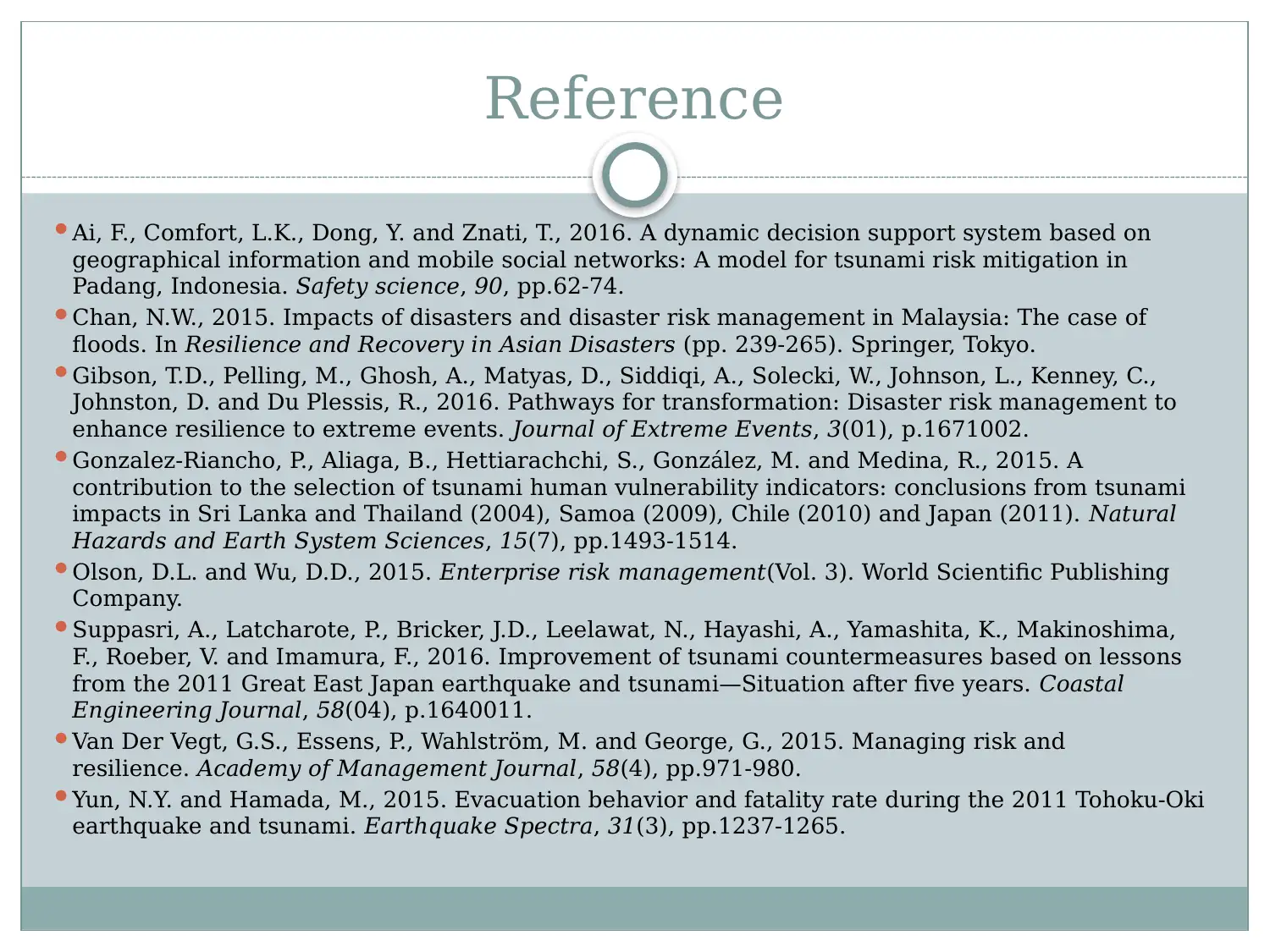
Reference
Ai, F., Comfort, L.K., Dong, Y. and Znati, T., 2016. A dynamic decision support system based on
geographical information and mobile social networks: A model for tsunami risk mitigation in
Padang, Indonesia. Safety science, 90, pp.62-74.
Chan, N.W., 2015. Impacts of disasters and disaster risk management in Malaysia: The case of
floods. In Resilience and Recovery in Asian Disasters (pp. 239-265). Springer, Tokyo.
Gibson, T.D., Pelling, M., Ghosh, A., Matyas, D., Siddiqi, A., Solecki, W., Johnson, L., Kenney, C.,
Johnston, D. and Du Plessis, R., 2016. Pathways for transformation: Disaster risk management to
enhance resilience to extreme events. Journal of Extreme Events, 3(01), p.1671002.
Gonzalez-Riancho, P., Aliaga, B., Hettiarachchi, S., González, M. and Medina, R., 2015. A
contribution to the selection of tsunami human vulnerability indicators: conclusions from tsunami
impacts in Sri Lanka and Thailand (2004), Samoa (2009), Chile (2010) and Japan (2011). Natural
Hazards and Earth System Sciences, 15(7), pp.1493-1514.
Olson, D.L. and Wu, D.D., 2015. Enterprise risk management(Vol. 3). World Scientific Publishing
Company.
Suppasri, A., Latcharote, P., Bricker, J.D., Leelawat, N., Hayashi, A., Yamashita, K., Makinoshima,
F., Roeber, V. and Imamura, F., 2016. Improvement of tsunami countermeasures based on lessons
from the 2011 Great East Japan earthquake and tsunami—Situation after five years. Coastal
Engineering Journal, 58(04), p.1640011.
Van Der Vegt, G.S., Essens, P., Wahlström, M. and George, G., 2015. Managing risk and
resilience. Academy of Management Journal, 58(4), pp.971-980.
Yun, N.Y. and Hamada, M., 2015. Evacuation behavior and fatality rate during the 2011 Tohoku-Oki
earthquake and tsunami. Earthquake Spectra, 31(3), pp.1237-1265.
Ai, F., Comfort, L.K., Dong, Y. and Znati, T., 2016. A dynamic decision support system based on
geographical information and mobile social networks: A model for tsunami risk mitigation in
Padang, Indonesia. Safety science, 90, pp.62-74.
Chan, N.W., 2015. Impacts of disasters and disaster risk management in Malaysia: The case of
floods. In Resilience and Recovery in Asian Disasters (pp. 239-265). Springer, Tokyo.
Gibson, T.D., Pelling, M., Ghosh, A., Matyas, D., Siddiqi, A., Solecki, W., Johnson, L., Kenney, C.,
Johnston, D. and Du Plessis, R., 2016. Pathways for transformation: Disaster risk management to
enhance resilience to extreme events. Journal of Extreme Events, 3(01), p.1671002.
Gonzalez-Riancho, P., Aliaga, B., Hettiarachchi, S., González, M. and Medina, R., 2015. A
contribution to the selection of tsunami human vulnerability indicators: conclusions from tsunami
impacts in Sri Lanka and Thailand (2004), Samoa (2009), Chile (2010) and Japan (2011). Natural
Hazards and Earth System Sciences, 15(7), pp.1493-1514.
Olson, D.L. and Wu, D.D., 2015. Enterprise risk management(Vol. 3). World Scientific Publishing
Company.
Suppasri, A., Latcharote, P., Bricker, J.D., Leelawat, N., Hayashi, A., Yamashita, K., Makinoshima,
F., Roeber, V. and Imamura, F., 2016. Improvement of tsunami countermeasures based on lessons
from the 2011 Great East Japan earthquake and tsunami—Situation after five years. Coastal
Engineering Journal, 58(04), p.1640011.
Van Der Vegt, G.S., Essens, P., Wahlström, M. and George, G., 2015. Managing risk and
resilience. Academy of Management Journal, 58(4), pp.971-980.
Yun, N.Y. and Hamada, M., 2015. Evacuation behavior and fatality rate during the 2011 Tohoku-Oki
earthquake and tsunami. Earthquake Spectra, 31(3), pp.1237-1265.
Paraphrase This Document
Need a fresh take? Get an instant paraphrase of this document with our AI Paraphraser

1 out of 8
Related Documents
Your All-in-One AI-Powered Toolkit for Academic Success.
+13062052269
info@desklib.com
Available 24*7 on WhatsApp / Email
![[object Object]](/_next/static/media/star-bottom.7253800d.svg)
Unlock your academic potential
© 2024 | Zucol Services PVT LTD | All rights reserved.





